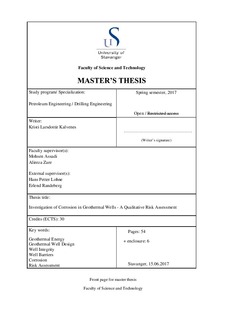| dc.contributor.advisor | Zare, Alireza | |
| dc.contributor.advisor | Lohne, Hans Petter | |
| dc.contributor.advisor | Randeberg, Erlend | |
| dc.contributor.advisor | Assadi, Mohsen | |
| dc.contributor.author | Kalvenes, Kristi Larsdottir | |
| dc.date.accessioned | 2017-10-20T09:50:15Z | |
| dc.date.available | 2017-10-20T09:50:15Z | |
| dc.date.issued | 2017-06-15 | |
| dc.identifier.uri | http://hdl.handle.net/11250/2461225 | |
| dc.description | Master's thesis in Petroleum engineering | nb_NO |
| dc.description.abstract | The petroleum industry uses a variety of qualitative risk assessment methods for maintaining well integrity, such as well barrier schematics and barrier diagrams. Identifying barriers and using well barrier schematics are helpful tools in qualitative risk assessments. However, it is not yet clear if these methods can be applied for risk assessments in the geothermal industry. Geothermal wells often produce directly through the casing, instead of through production tubing, making it difficult to identify two independent barrier envelopes in accordance to NORSOK D-010.
High temperatures and corrosion are the most common contributors to failure in geothermal wells. In this study, a hypothetical case of a downhole corrosion problem was assessed by means of conducting a qualitative risk analysis and identifying well barriers in a geothermal well.
This study shows that qualitative risk assessment methods from the petroleum industry are applicable using minor adjustments to well barrier interpretation and barrier diagrams. Using NORSOK D-010 as a guideline, the study found that typical Icelandic high temperature geothermal wells may consist of a primary and a secondary barrier envelope with a common well barrier element at the wellhead. At shallow depths, the intermediate casing, often the anchor casing, acts as a secondary barrier against an aquifer. In addition, the study indicates that production of low enthalpy fluids and its financial impact might be the main concerns of downhole corrosion problems close to the production casing shoe.
Findings in this study could form the foundation for raising the standard of risk assessment methods for high temperature geothermal wells, and the well barrier interpretations defined in this thesis may be suitable for a number of these types of wells. | nb_NO |
| dc.language.iso | eng | nb_NO |
| dc.publisher | University of Stavanger, Norway | nb_NO |
| dc.relation.ispartofseries | Masteroppgave/UIS-TN-IPT/2017; | |
| dc.subject | geothermal energy | nb_NO |
| dc.subject | geothermal well design | nb_NO |
| dc.subject | well integrity | nb_NO |
| dc.subject | well barriers | nb_NO |
| dc.subject | corrosion | nb_NO |
| dc.subject | risk assessment | nb_NO |
| dc.subject | petroleumsteknologi | nb_NO |
| dc.subject | petroleum engineering | nb_NO |
| dc.subject | boreteknologi | nb_NO |
| dc.title | Investigation of Corrosion in Geothermal Wells - A Qualitative Risk Assessment | nb_NO |
| dc.type | Master thesis | nb_NO |
| dc.subject.nsi | VDP::Teknologi: 500::Berg‑ og petroleumsfag: 510::Petroleumsteknologi: 512 | nb_NO |
